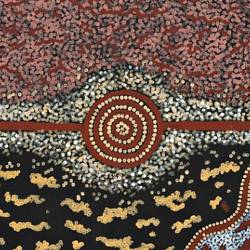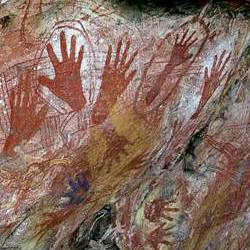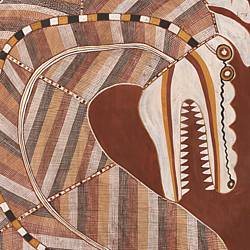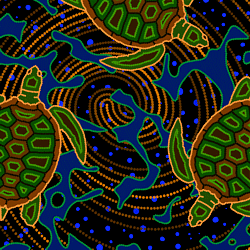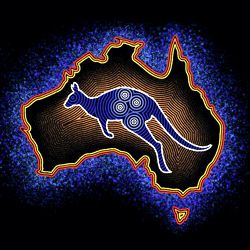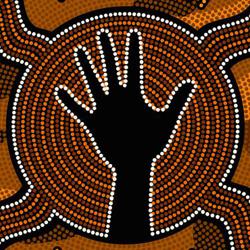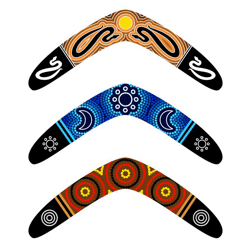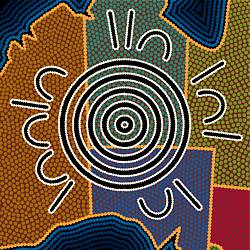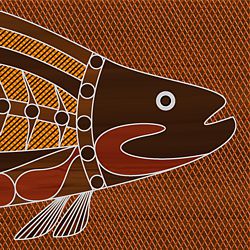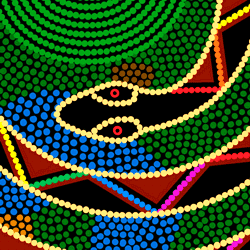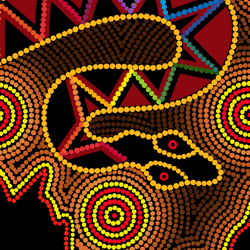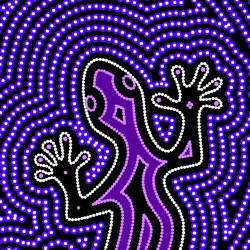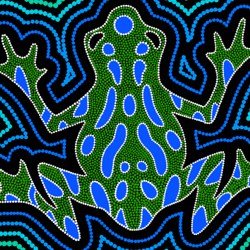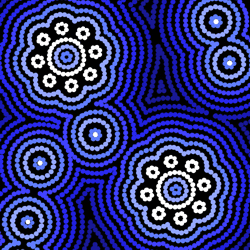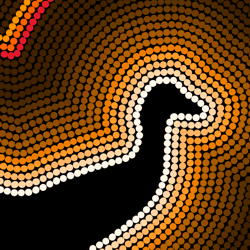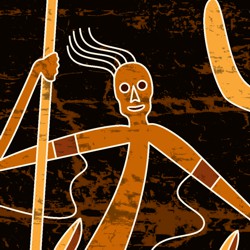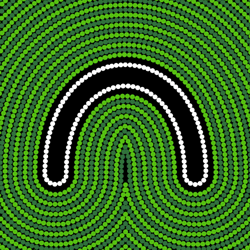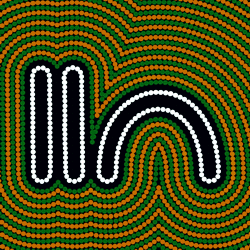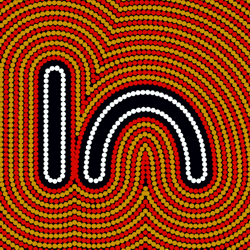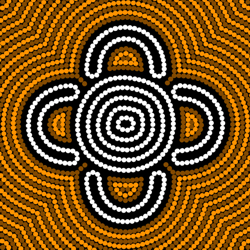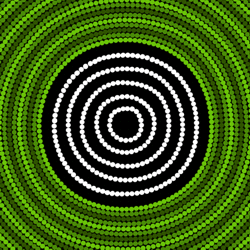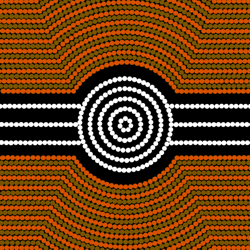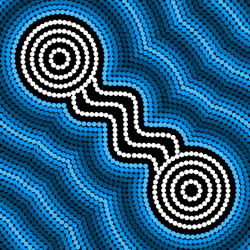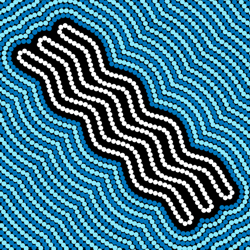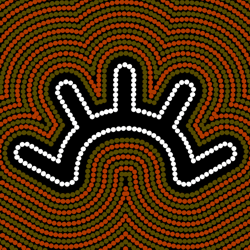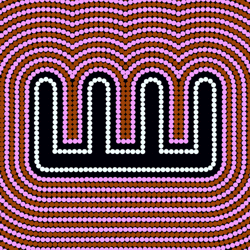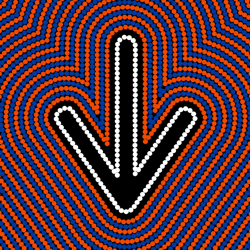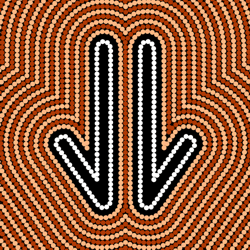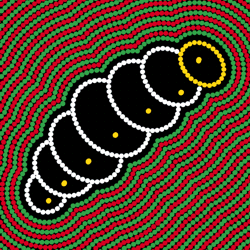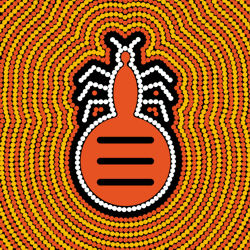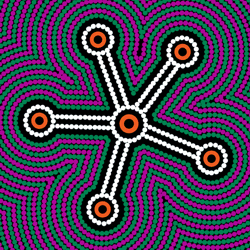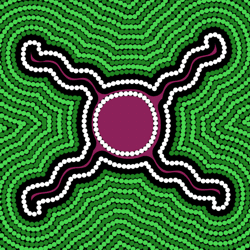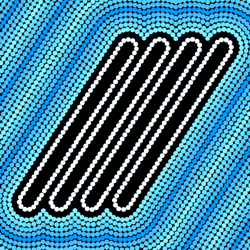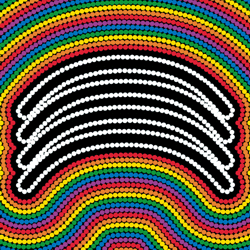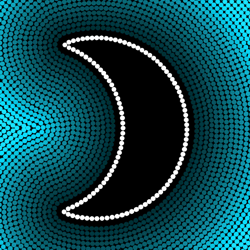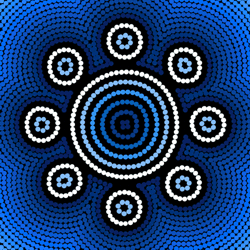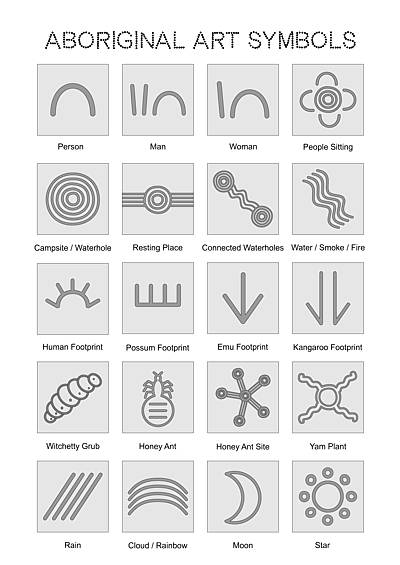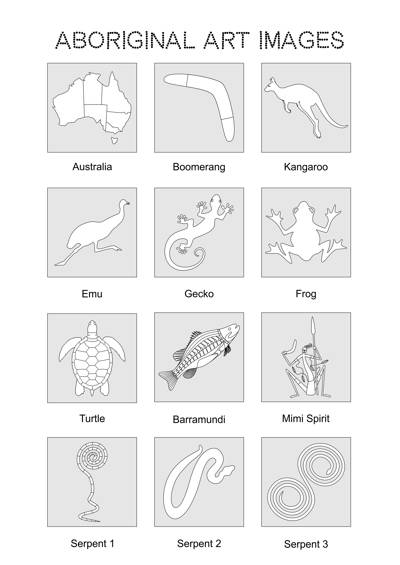Aboriginal Art Dreaming Stories - The Rainbow Serpent
The Rainbow Serpent is a Dreaming spirit that has many names and legends. What unites them is their creation stories that describe the beginning of the world.
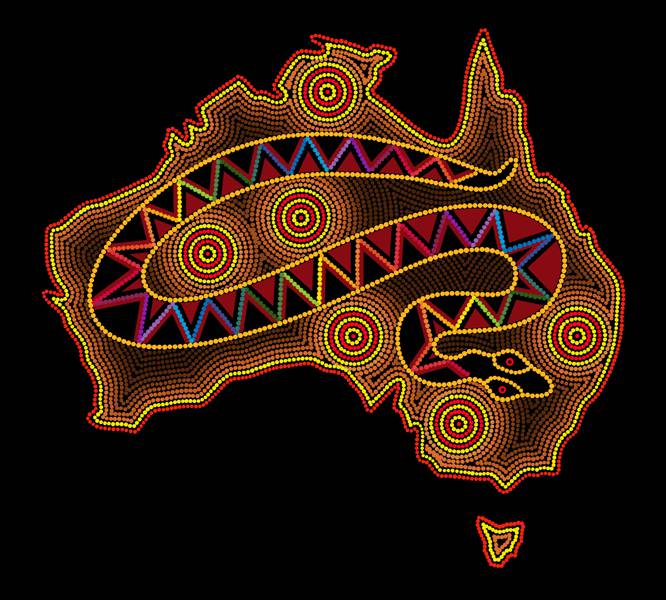
'The Rainbow Serpent'
Long ago in the Dreaming the earth was silent and the giant Rainbow Serpent slept in the darkness. All the animals were asleep inside her [1] waiting to be born. Then one day the Rainbow Serpent woke up and emerged from the darkness to wind her way across the land. As she slithered back and forth, her massive body carved out the mountains and valleys, creating hollows for the lakes and channels for the rivers.
After she created the forms of the landscape she returned to the darkness and called out the frogs. They emerged slowly from their slumbers with their stomachs full of the water they had stored for their long sleep. Then the Rainbow Serpent tickled their stomachs to make them laugh, which released their water across the land, filling up the rivers and lakes. When the grass grew and the flowers blossomed and the trees bore fruit, all the other animals woke up and followed the Rainbow Serpent to this beautiful land. Some lived on the grassy planes, some on the craggy rocks, some in the trees, some in the rivers and lakes and some in the sky. They formed their own tribes and were happy in their new home.
Then the Rainbow Serpent created some new laws to help solve any disagreements in a fair manner, but despite this some of the animals would still argue and complain. The Rainbow Serpent was unhappy with the behaviour of these ungrateful creatures and announced, "If you keep the law you will earn the right to human life, but if you break the law you will be turned into stone and sleep forever." So those who broke the law were turned to stone and formed the rocks and boulders of the mountains. But those who kept the law were rewarded with human life and a tribal totem representing the kind of creature they used to be: a kangaroo, emu, wombat, snake, frog, bird, fish and so on.
As people, they recognized one another and knew which tribe they belonged to by their totems. They lived in harmony and loved the life and land that the Rainbow Serpent gave them, confident in the belief that it would always be theirs and that no one could take it from them.
‘The Rainbow Serpent’ is a Dreaming spirit that has many names [2] and legends. What unites them is their creation stories that describe the beginning of the world, the birth of mankind and the establishment of law and order. The Rainbow Serpent is one of the oldest creation stories and continues to influence contemporary culture inspiring new artwork, literature, music and social movements both in Australia and beyond.
The Painting Process for our Page Illustration
Many of the topics in our Aboriginal Art pages are illustrated with a painting that was inspired by the theme of that page. For each of these we have created a step by step slide show that deconstructs the image to reveal the painting process and inspire possibilities for your own ideas. The images and symbols used to create our illustrations can be found in our menu at the foot of the page. They are available for you to download to help with creating your own artworks.
- aboriginal-art-rainbow-serpent-13
The Rainbow Serpent
- aboriginal-art-rainbow-serpent-2
1. The outline of the map of Australia is drawn with a white color pencil on a black ground.
- aboriginal-art-rainbow-serpent-3
2. A sinuous serpent is drawn within the map.
- aboriginal-art-rainbow-serpent-4
3. Circles representing the movement of landmasses are pushed around by the serpents twisting body.
- aboriginal-art-rainbow-serpent-5
4. The map of Australia is outlined with red dots.
- aboriginal-art-rainbow-serpent-6
5. The serpent is outlined with orange dots.
- aboriginal-art-rainbow-serpent-7
6. The landmasses are outlined with yellow dots.
- aboriginal-art-rainbow-serpent-8
7. A deep red zig-zag pattern is painted to represent the markings on the serpent's body.
- aboriginal-art-rainbow-serpent-9
8. The edges of the serpent's markings are dotted with the colors of the rainbow.
- aboriginal-art-rainbow-serpent-10
9. The landmasses are dotted with concentric rings of yellow and red to identify them as campsites.
- aboriginal-art-rainbow-serpent-11
10. An interior contour of yellow dots is drawn within the map.
- aboriginal-art-rainbow-serpent-12
11. Further concentric contours of darkening ochre colors are dotted within the map and around the campsites.
- aboriginal-art-rainbow-serpent-13
12. The interior of the map is filled with gradually darkening contours to suggest the 3-dimensional nature of the land.

(Click on the play buttons or swipe back and forward to explore each stage of our painting.)
Key Stages of the Painting
-
The outline of the map of Australia is drawn with a white color pencil on a black ground.
-
A sinuous serpent is drawn within the map.
-
Circles representing the movement of landmasses are pushed around by the serpents twisting body.
-
The map of Australia is outlined with red dots.
-
The serpent is outlined with orange dots.
-
The landmasses are outlined with yellow dots.
-
A deep red zig-zag pattern is painted to represent the markings on the serpent's body.
-
The edges of the serpent's markings are dotted with the colors of the rainbow.
-
The landmasses are dotted with concentric rings of yellow and red to identify them as campsites.
-
An interior contour of yellow dots is drawn within the map.
-
Further concentric contours of darkening ochre colors are dotted within the map and around the campsites.
-
The interior of the map is filled with gradually darkening contours to suggest the 3-dimensional nature of the land.


